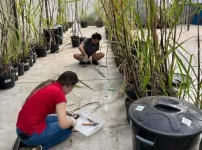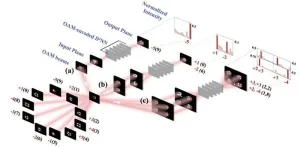Dutch researchers explore patient profiles of those who choose to stop eating and drinking to hasten death
Some patients choose to voluntarily stop eating and drinking (VSED) as a way of hastening death.
2023-11-27
(Press-News.org)
Some patients choose to voluntarily stop eating and drinking (VSED) as a way of hastening death. Researchers from the Amsterdam University Medical Centre conducted a study to describe patients’ motives for doing so, how they decide to voluntarily stop eating and drinking, and the way in which they prepare to do so, along with how they involve others. The researchers conducted qualitative interviews with 29 patients living in the Netherlands. Among 29 cases, 24 started VSED and 19 died. Thirteen cases were included before and during VSED and 16 afterwards. Study participants include 17 patients, 18 informal caregivers, and 10 professional caregivers.
Researchers identified three specific groups of patients who decided to adopt VSED to hasten death. Older people who felt their lives were complete and valued control over the end of their lives were well prepared to carry out VSED and could overlook the need for help and the emotional burden they would have placed on relatives. The second group were older, care-dependent patients with poor quality of life. They often started VSED suddenly and relied heavily on mostly informal caregivers for the preparation and execution of their end-of-life plans. The third group were mostly younger psychiatric patients with a long-lasting, though often fluctuating, wish to control their own deaths. These patients often prepared for VSED in secrecy or initiated VSED unprepared.
What We Know: In the Netherlands, general practitioners usually provide care for a patient who chooses to hasten death by voluntarily stopping eating and drinking.
What This Study Shows: Patients who seek to hasten death by voluntarily stopping food or liquid consumption can be divided into three categories: older patients who seek control over their lives; those who wish to hasten a natural death; and those who want to end their lives through suicide. The researchers explore the background and motive, considerations and expectations; involvement of others, and outcome trajectory for each group. They conclude that since patients who choose VSED are varied, it is important that professional and patient guidance apply to all patients considering VSED, no matter their reason for choosing to hasten their own deaths.
Patients Who Seek to Hasten Death by Voluntarily Stopping Eating and Drinking: A Qualitative Study
Eva Elizabeth Bolt, MD, PhD et al
Amsterdam University Medical Center, The Netherlands
Pre-embargo article link (Link expires at 5 p.m. EDT Nov. 27, 2023)
Permanent link
END
ELSE PRESS RELEASES FROM THIS DATE:
2023-11-27
Researchers performed an analysis to assess the proportion of accredited U.S. family medicine residency programs and trainees in states with abortion restrictions. Of 693 accredited family medicine residency programs in the U.S., 201 programs (29%) were in states where abortion was banned or heavily restricted as of August 2, 2023. Fourteen of the 17 states in this category had complete abortion bans.
While most (63.8%) family medicine residency programs were in states with at least some abortion restrictions, 251 ...
2023-11-27
In an effort to fill the need for primary care–focused guidelines, an international group of top researchers has developed the Consensus Reporting Items for Studies in Primary Care (CRISP) Checklist, which outlines 24 items that describe the research team, patients, study participants, health conditions, clinical encounters, care teams, interventions, study measures, settings of care, and implementation of findings and results in primary care. The CRISP Working Group conducted a scoping review of literature on the state of primary care research reporting as well as several rounds of online surveys to assess ...
2023-11-27
Researchers have discovered that a part of the brain associated with working memory and multisensory integration may also play an important role in how the brain processes social cues. Previous research has shown that neurons in the ventrolateral prefrontal cortex (VLPFC) integrate faces and voices—but new research, in the Journal of Neuroscience, shows that neurons in the VLPFC play a role in processing both the identity of the “speaker” and the expression conveyed by facial gestures and vocalizations.
“We still don’t fully understand how facial and vocal information is combined and what information is processed by different ...
2023-11-27
New research from McMaster University has found that not only is virtual care a safe way to hold medical appointments, but that patients and physicians were able to use it appropriately and effectively with minimal guidance.
The study, published in Healthcare Quarterly on Nov. 27, was led by Shawn Mondoux, an emergency physician and associate professor in the Department of Medicine at McMaster. Mondoux and his team wanted to find out just how safe virtual care is when compared to an in-person assessment.
To do this, researchers keyed in specifically on virtual ...
2023-11-27
Parents who send their children to child care can breathe a little easier – research published in JAMA Network Open from experts at Michigan Medicine, the University of Pittsburgh School of Medicine, and UPMC Children’s Hospital of Pittsburgh shows that children in daycare were not significant spreaders of COVID-19.
The study found that transmission rates of SARS-CoV-2 within child care centers was only about 2% to 3%, suggesting that children and caregivers were not spreading COVID at significant rates to others ...
2023-11-27
To reach the world’s goal of carbon neutrality by 2050, there must be a fundamental change in electronic materials to create a more reliable and resilient electricity grid. A diamond might be a girl’s best friend, but it might also be the solution needed to sustain the electrification of society needed to reach carbon neutrality in the next 30 years. Researchers at the University of Illinois Urbana-Champaign have developed a semiconductor device made using diamond, that has the highest breakdown voltage and lowest leakage current compared to previously reported diamond devices. Such a device will enable more efficient technologies needed as the world transitions to renewable energies.
It ...
2023-11-27
Publications on sugarcane have increased exponentially since 2006 worldwide, and Brazil has had more articles published on the topic than any other country in the period, according to a review in BioEnergy Research.
The number of articles on the subject averaged about five per year between 1999 and 2006 but had reached 327 by 2021. Brazil has twice as many articles on sugarcane as the United States, which ranks first in the world for scientific publications in general. Brazil is also ahead of Australia, China and India, which are also major sugarcane growers.
According to the authors of the review, who are affiliated with the Laboratory of Plant Physiological Ecology (LAFIECO) ...
2023-11-27
Messenger bubbles produced by human cells can pick up bacterial products and deliver them to other cells, University of Connecticut researchers report in the Nov. 16 issue of Nature Cell Biology. The discovery may explain a key mechanism by which bacteria, whether friendly or infectious, affect our health.
Extra-cellular vesicles (EVs) are like a postal service for our cells. Cells produce the EVs, tiny bubbles with a water-resistant shell made of fatty substances called lipids, and send them into the bloodstream. When another cell comes across an EV, it takes it inside itself ...
2023-11-27
Deep learning has revolutionized the way we perceive and utilize data. However, as datasets grow and computational demands increase, we need more efficient ways to handle, store, and process data. In this regard, optical computing is seen as the next frontier of computing technology. Rather than using electronic signals, optical computing relies on the properties of light waves, such as wavelength and polarization, to store and process data.
Diffractive deep neural networks (D2NN) utilize various properties of light waves to perform tasks like image and object recognition. Such networks consist of two-dimensional pixel arrays as diffractive layers. Each pixel serves as an adjustable ...
2023-11-27
Many gig workers experienced financial hardships during the COVID-19 pandemic, including food insecurity and trouble paying bills, according to a recent study published in Work and Occupations.
“In a nutshell, our study shows gig workers were harmed more by the COVID-19 pandemic than any other workers,” said Dr. Mathieu Despard, a co-author on the paper and faculty member in UNC Greensboro’s Department of Social Work.
Despard – who collaborated closely with first author Daniel Auguste ...
LAST 30 PRESS RELEASES:
[Press-News.org] Dutch researchers explore patient profiles of those who choose to stop eating and drinking to hasten death
Some patients choose to voluntarily stop eating and drinking (VSED) as a way of hastening death.

